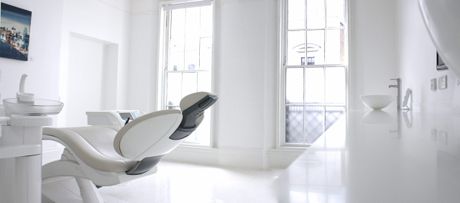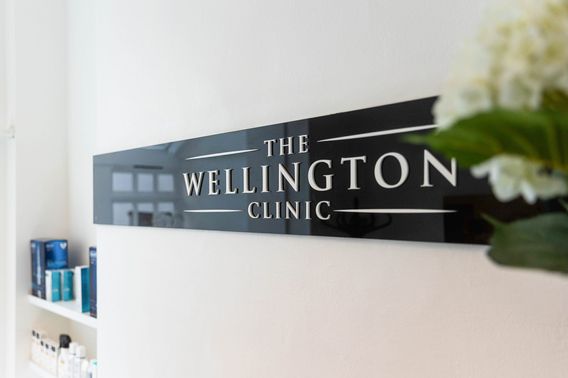
Specialist orthodontist at our Reigate clinic
Patients across Surrey book orthodontist appointments at The Wellington Clinic for superior expertise in straight teeth and beautiful smiles in premium surroundings.
Our specialist orthodontist works with children and adults, transforming lives and boosting confidence. We are proud to offer the finest dentistry at its best.
What are the benefits of orthodontic treatment?
Positioning your teeth correctly not only makes them look wonderful, it also improves function. Teeth are easier to keep clean, lessening the risk of decay or gum disease.
Reasons why people have orthodontic treatment include:
- Overcrowding of teeth.
- Gaps between teeth.
- Asymmetrical teeth.
- Protruding teeth.
- Deep bite (upper teeth overlap and cover lower teeth too much).
- Reverse bite (upper teeth bite inside lower teeth).
- Open bite (front teeth remain apart when back teeth meet).
The safest way to straighten your teeth is to see a specialist orthodontist, and at our Reigate dental clinic on Church Street we have some of the UK’s leading professionals.
Why do people have orthodontics?
Benefits of orthodontics include:
-
Greater self confidence
Thanks to improved appearance and a lovely smile.
-
Gum disease prevention
Less chance of gum disease or decay because straight teeth are easier to clean.
-
Equal distribution of pressure
This is better for your jaws and is achieved once bite has been improved.
-
Prepare your teeth
For restorative care in the future.
What is a Specialist Orthodontist?
A specialist orthodontist is a fully qualified dentist who has undertaken at least an additional three years’ training and examinations to specialise in orthodontics.
Our specialist orthodontist in Reigate is Dr Stephanie Oiknine. Stephanie completed her specialist training in orthodontics at King’s College London and is a member of the Royal College of Surgeons.
Book an appointment with Stephanie today.
Surrey orthodontist – your consultation
Your orthodontist will carry out a full assessment of your teeth, usually taking photographs and a jaw X-ray to study your roots. The next step is to discuss your options for braces, costs and how long you can expect your treatment to take.
Braces
A brace or orthodontic appliance is used to straighten your teeth. They can be either fixed or removable and work by applying gentle pressure to gradually shift your teeth to the correct position.
If they are removable you can take them out to eat and drink, and to clean them. If they are fixed, they are permanently attached until your treatment ends.
To straighten your teeth discreetly we can offer hidden braces that sit behind your teeth so they are almost invisible or Invisalign which you can also remove for easier cleaning.

Teeth straightening
Tooth-coloured ceramic braces to match your other teeth, transparent braces, lingual braces or removable invisible braces such as Invisalign can all be used for your teeth straightening. Fitting them is simple.
How orthodontic treatment works
There may be some initial discomfort as your teeth and gums adjust which is normal and usually disappears after a few days. Awkward speaking and eating will also pass with a little time.
After a couple of weeks, you may even have forgotten you are wearing a brace.
Scheduled visits with your specialist orthodontist
We know our patients will be travelling from all over Surrey for outstanding orthodontics treatment at our Reigate dental clinic. We confidently believe it will be worth it.
We will see you every 4-10 weeks to check on progress and adjust your brace so your teeth straightening is as streamlined as possible. This can take from six months to two years, wearing your braces either all the time or for a certain number of hours every day. If this sounds like a long time, be reassured that you will see improvements very quickly and these timings are for your final results.
Orthodontist FAQs
-
What is the best age to have a brace?
You can have braces at any age; from as young as 7 to as old as 100.
Younger children can see an orthodontist from 7 years old. There will be a mix of baby and adult teeth at this age and although it will not be possible to straighten all the adult teeth, it is important to correct certain problems and prevent more complications that will result in more complicated treatment at a later stage. The younger age is also ideal to encourage bone growth if required for jaw corrections; this will not be possible once the child has stopped growing.
Adults can have braces at any age. It’s never too late to straighten your teeth. In fact, straighter teeth will help you to have a better bite and function and to help you keep your teeth cleaner and maintain healthier gums.
-
What should I expect on the first visit to the clinic?
When you first visit us, we’ll carry out an examination and make detailed plans and notes regarding potential treatment plans. We’ll also discuss cost and payment plans with you at this time. Contact us today for access to the best Reigate orthodontists available.
-
How much do braces cost?
The price of braces generally varies from around £3500 to £9800. Most braces will average around £4500-£5000.
The cheapest braces are generally fixed metal braces. Fixed ceramic braces are normally an upgrade of a few hundred pounds extra. Invisalign (removable clear aligner) braces can be a similar price and Lingual fixed braces are the most expensive at around £7500-£9000.
The price will also depend on whether the treatment required is simple and quick or if it is complex and lengthy. The orthodontist will need to examine and assess your teeth to calculate the length of time it will take to straighten in order to calculate the exact cost.
Retainers will be needed at the end of treatment and can be around £150 to £400 per arch depending on the types of retainers required.
-
How long does it take for teeth to move with braces?
Orthodontic treatment can be completed in as short as 6 months for very minor tooth movements or it can take up to 2 years for more complex treatments. Most cases will generally take 12 to 18 months for the teeth to line up neatly. It all depends on whether the teeth were very crowded to begin with or just a little.
Teeth can start to move quite quickly and with Invisalign type braces you will move to the next aligner every 1-2 weeks. With fixed braces you will need to see the orthodontist every 6 -8 weeks.
-
Which brace is best?
All the braces can be as good as each other if in expert hands. The best thing to do is to see an orthodontist who provides treatment with all the different brace types.
If the orthodontist does not use Invisalign or lingual braces for example, then they would not be able to discuss these options with you. The orthodontist can help to guide you in your decision making.
Occasionally there may also be a specific tooth movement that may be more efficiently or effectively completed with a particular brace so the orthodontist can help advise if that is the case. Invisalign is removable but will need to be worn for 23 hours per day so you need to be committed for this brace option.
Lingual braces will be fixed to the inside of your teeth and closer to your tongue so may take a little longer to get used to. The lingual brace will initially give you a lisp until you adapt to it being there.
-
How do I choose which brace to have?
There are many types of braces to choose from. Cost and appearance tend to be the main deciding factors.
If cost is the most important factor then traditional metal braces are most likely to be the cheapest, followed by ceramic braces and then Invisalign. Lingual braces are almost double the price of the other types.
If the most important thing is appearance, then the lingual brace is the least visible, followed by Invisalign and then ceramic braces. The traditional metal braces are the least discreet.
Invisalign type braces, although removable, need to be worn for 23 hours per day, so if you are unable to commit to this, then fixed braces may be a better option for you.
Occasionally certain tooth movements can also influence the brace type used and an orthodontist who provides all the brace options can guide you on whether one brace can achieve certain movements better.
-
How are braces fitted and removed?
Fixed braces comprise of small rectangular brackets (one for each tooth) and a wire. The brackets are glued to each tooth and once they are glued in the correct positions the wire is slotted into the bracket grooves. Small elastic bands are popped over each bracket keeping the wire held on tightly. At the end of treatment, the brackets are gently lifted off the tooth. The tooth is then polished to remove any remaining glue.
Invisalign braces comprise of a set of clear plastic aligners which are removable. However, there will normally be a few small attachments that will be glued to a few of the teeth. The attachments are tiny clear blobs and when the aligners are not in the mouth you can barely see them. At the end of treatment the blobs are shaved back and the tooth is polished.
-
What happens after braces come off?
Once the brace is removed it is extremely important to have retainers to hold the teeth in their new positions. Teeth will unfortunately move back if they are not held in position permanently.
There are 2 main types of retainers; fixed and removable. The fixed wire retainer is a thin wire that is glued to the back of the front 6 teeth. This wire prevents rotations of the front teeth. The removable retainer is commonly a clear plastic tray which wraps around all the teeth. The removable retainer prevents larger tooth movements and changes in the shape of the arch as well as holding the front teeth in position.
Both retainers are recommended best practice as the removable retainer will only be worn during the night. The fixed wire retainer will be permanently holding the front teeth secure.
The Wellington Clinic
To find out more about orthodontic treatment, or to book an appointment with our orthodontist in Reigate, call 01737 448 055, or book online.